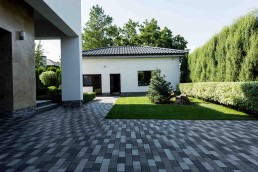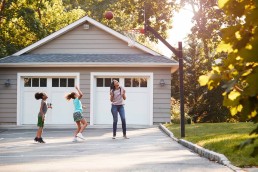5 Home Maintenance Tips To Avoid Water Damage
Water damage is something that most homeowners want to avoid at all costs. Water is only designed to be present in a regulated manner within the building structure, in supply pipes, drain pipes, sinks, and basins. Water should never be allowed to accumulate in crawl spaces, basements, floors, or walls. Solutions like basement waterproofing prove effective at protecting an entire space from potential water damage. In addition, there are fixes and preventative measures that can save you from small water leaks to serious water damage that requires costly professional work to repair.
1. Protect your drains
Sinks are designed to collect water and direct it to the sewer main through waste pipes. Every component of that system must work flawlessly. Otherwise, wastewater will seep into sink cabinets. Furthermore, branch lines to the drain-waste-vent might leak across floors or within walls. To Keep your sinks and drains in good working order there are a number of maintenance and preventive measures you can employ. One way to ensure healthy and flowing drains is to avoid pouring grease down drains because it can quickly solidify in sections of the piping and cause clogs and can be very difficult to remove. It is best to also keep a strainer in place on a sink and shower drains to prevent any debris that can cause clogs from getting in. By having a strainer, they should be cleaned often to remove any caught debris and thrown into the trash. As part of your maintenance checklist to ensure healthy and flowing drains you can inspect visible piping located under sinks and toilets and ensure that the drains are not leaking. In the case that they are it is best to replace the piping immediately.
2. Regularly check and clean your sump pump
To avoid water damage it is important that your sump pump is properly working so that it is ready to pump water out of your basement in an event that excess water enters your living space. When there is a problem with your sump pump, there are warning indications to watch for. You should look out for strange pump noises that may indicate worn-out components. Noises such as rattling or grinding might indicate a stuck or broken impeller. Along with noises, excessive vibration in the motor might also indicate that the impeller is bent or distorted which may need to be fixed or replaced. Another issue to look for is if the sump pump is cycling on and off when it should be functioning might indicate an issue with the internal wiring. While an oil leak may indicate that the sump pump may fail shortly. If you see any of these symptoms, contact a professional immediately since your sump pump may require expert maintenance or replacement.
As a homeowner, the best way to ensure your sump pump is functioning properly is the overall cleanliness of the machine. It is essential for sump pump and sump pit maintenance. Cleanliness boosts the longevity and efficiency of your equipment. To clean your sump pump and sump pit you should first turn off the sump pump and ensure no one is using any appliance that will drain water into the sump pit like a washing machine. Once off you can begin to rinse the pump using a hose. Then, using a plastic scraper or putty knife, scrape away the caked particles. Clean out the sump pit using a wet vac and reattach the pump to the discharge pipe and reconnect it to its power source once it is dry. Sump pump maintenance ensures that your equipment is functioning when you need it most.
3. Ensure proper land grading
Grading the surface around your home is important for the natural runoff of water. This ensures that water does not settle in any areas of your home that can cause damage to any exterior surface or from the water seeping down into the ground and potentially into your basement. Uneven soil hampers effective water drainage, and during heavy rain, water might flow towards rather than away from the property. Water might potentially collect around the foundation, causing fractures or, in worst-case circumstances, floods.
Land grading prevents water from pooling near your home's foundation and directs any rain or stormwater away from your property by modifying the surface angle. Water drainage is critical to any building project, and when a trained professional does land grading, the right drainage channels are built and used to ensure the structure of your property. To ensure that your property is appropriately graded it is important to routinely walk around your home after rainfall and inspect any areas that have settled water. If you find a number of areas around your home that have pooling water it may be time to have the surface graded to ensure proper drainage.
4. Clear the gutters and downspouts of debris
It is critical to maintain your gutter system all year, especially if you reside in a rainy area. Normally, you can predict when the cold and wet months will arrive, but storms sometimes appear suddenly, and when that happens, you will want to make sure your gutters and downspouts are ready to withstand the surge of rain. In addition, when gutters get blocked and neglected, they can sustain damage. If there is too much debris in the gutters and downspouts, the weight will cause the gutters to droop and the gutters will be unable to manage the rainwater levels. Gutter systems age and require repairs over time, so it is critical to inspect them on a regular basis to ensure they are working to their full potential. Gutter maintenance needs frequent inspections. Your gutter system should survive for years if you keep them debris free and ensure that the gutter system is still sturdy.
5. Apply caulk to major areas in your home
Caulk is an essential component in every bathroom or kitchen. It keeps water from getting into places it should not be. Caulk, on the other hand, is frequently one of those things that we set and forget. You can look for some telltale signs that you may need to recaulk your sink or bathtub. Some signs to look out for are peeling, cracking, and missing pieces. Peeling and splitting allow moisture to become trapped behind the caulking, potentially causing mold or water damage. This might also indicate that the present caulk was not suitable for the task. When it comes to kitchens and bathrooms, it's critical to use a waterproof caulk. Another sign to look for is the buildup of mold or mildew. Mold creates a variety of issues as it can aggravate allergies, damage your home, and just look unappealing. Mold thrives in moist surroundings, so bathrooms and kitchens are ideal places for it to grow. If you find mold or mildew in your bathroom, you should inspect your caulk. One of its functions is to keep mold from growing between the tub, sink, or shower and the wall or floor. Even though the tub and wall appear to be snugly fit, moisture can sneak in-between surfaces and cause mold to thrive without the protective barrier of waterproof caulk. You can easily replace caulk around your home with simple tools from the hardware store and proper application. This simple preventative measure can easily prevent water damage.
Therefore, regardless of the origin of the water damage, you may utilize all of these tips to help prevent the chance of bursting pipes, water damage, and flooding in your house. Preventative actions will help you avoid or reduce the likelihood of this severe damage from ever occurring.
15 Metal Roof Projects for Inspiration
15 Metal Roof Projects for Inspiration
Ready to get Started on your ROOF Replacement Project?
7 Kitchen Styles to Consider for your Kitchen Remodel
Farm House
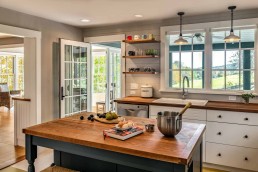
Generally speaking, a farmhouse kitchen design is very approachable and unpretentious. Infused with personality, farmhouse kitchens feature warm elements such as wood, brick, and metal. Old-school prints, distressed furnishings, and vintage finishing touches contribute to a lived-in aesthetic.
Old World
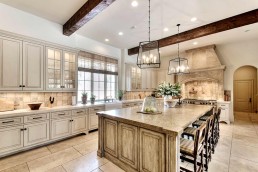
Old World kitchen designs borrow from the vast array of styles from European history prior to the 1600s. With natural materials and earthy colors foremost in the design palette, an Old World style kitchen combines heavy proportions with luxurious attributes.
Modern
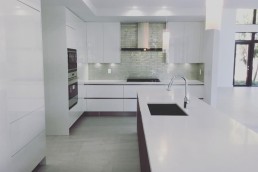
Sleek, sophisticated, minimalist, yet functional. That describes the modern kitchen. A modern kitchen has minimalist styling with an open layout and clean lines. It is highly functional with the latest appliances and the use of natural materials. Homeowners that are interested in an efficient space with sophisticated accents will gravitate toward a modern kitchen.
Ready to get Started on your KITCHEN Renovation Project?
Traditional

The traditional kitchen is one of the most popular design styles when it comes to creating a room everyone will enjoy. Traditional styling speaks to a great many people, and it’s a top design choice for many families.
The traditional kitchen allows for flexibility, but it most often relies on simple design while making way for a few bold accents. For example, a white kitchen with black granite countertops might include a standout centerpiece, like a bold red kitchen island. These design choices maintain the overall look of a traditional kitchen while adding a bit of spunk to the design.
Contemporary

Contemporary kitchens are a mix of your personality with functional aesthetics. These kitchen are famous for their sleek cabinetry and sophisticated color schemes. Contemporary kitchens are blended with the modern and minimalistic aesthetic to create a unique look that goes beyond the trends.
Industrial

Industrial-style kitchens are simple, utilitarian spaces where raw materials and tough fixtures and finishes take center stage — think of surfaces like concrete and steel, exposed brick and plenty of open space. Here are some common elements to look for: Tough materials such as concrete, steel, brick and wooden beams.
Coastal

Any change from installing pastel appliances to incorporating splashy light fixtures can convert your current kitchen into something you’d find featured in your favorite beach home. These expertly designed kitchens will make you consider investing in a renovation or sprucing up your current space by adding some seashell decor.
5 Questions To Ask When Choosing Replacement Windows
Since the lifespan of windows and doors lasts for years, homeowners may not have the expertise in selecting replacements. As a result, homeowners may never fully learn how to do it correctly. If you are searching for new windows there are a few things you should ask before making a purchase. To get a window replacement that fits your needs, looks visually appealing, and functions properly, here are 5 questions to ask when choosing replacement windows:
1. What is the best window style for my home?
When choosing replacement windows, asking which window style would best match your home will depend on a number of factors. Some window styles work better in certain home areas while others may not be ideal for that section. There are a variety of window styles to choose from with several customizations of materials, mechanisms, and functional features. Some window types to choose from are hinge or crank, single or double hung, bay or bow, horizontal sliders, fixed, and completely custom windows.
As an example, hinge or crank windows are a popular choice for most homes because of their ease of use, the max amount of ventilation they can let in, as well as allowing a great deal of natural light. Hinge or crank windows are ideal for almost anywhere in the home because of their versatility. However, the only place it should not be installed is in areas where the window would open to an immediate fence or tree. Due to how these windows open outwards, any obstructions in their direct vicinity can prevent hinge or crank windows from fully opening.
Another style of window to consider is bay or bow windows. They are a combination of three windows joined at an angle and they stick out just beyond your walls to add space to your room. Due to their angled design, bay or bow windows can add a panoramic-style view to a room in your home which is great if you are looking out at beautiful scenery or like to keep an eye on your front yard. In addition, due to their size, they let in an abundant amount of natural light. However, because these windows are larger in design they are best placed in open areas of the home like the living room. Since each room in the home may have different uses, multiple window styles can be used for those spaces, which is often the case. Selecting the right style of window for your home can come down to the room’s function and your personal preferences.
2. Are these windows energy efficient?
Along with the look and function of the window an important feature to consider when choosing replacement windows is their energy efficiency. Since energy-efficient windows can reduce the transfer of heat they can assist in lowering monthly utility bills. When choosing replacement windows you could look for an Energy Star label which indicates that the window has gone through tests and has met government-defined requirements. Hence why finding that label first can be a direct indication of the window’s energy efficiency. However, there are other features that make a window energy efficient such as the type of pane, the use of argon gas, and Low-E glazing.
Double and triple pane glass: Replacement windows are normally available with two glass pane options: double and triple pane. The typical option is a double pane, which consists of two panes of glass separated by airspace in the middle. Triple pane glass has an additional pane of glass as well as more airspace. It offers enhanced energy savings and sound-blocking capabilities.
Argon gas filled: An odorless, invisible gas that is denser than air. This gas is frequently poured between the gas panes in dual pane windows. The gas fill serves to improve the thermal efficiency of the window.
Low-E glazing: Low-E is an invisible covering that is extremely thin. Depending on the manufacturer, it is applied to the exterior or interior pane of glass. Low-E is used to limit heat transmission in the home. In the summer, it reflects sunlight back outside, preventing the home from heating up. In contrast, during the winter it allows sunshine to pass through the glass, naturally keeping the home warm.
Find a Window Replacement Professional
Are you looking to replace your windows?
3. Which material should I choose for my replacement windows?
While the materials used to make a window frame have an impact on its thermal capabilities, they have a considerably bigger impact on its physical features, such as thickness, weight, and durability. Selecting a window material can come down to what you are looking for aesthetically in a replacement window, its energy efficiency, and required maintenance. The following are some of the most common conventional window frame options:
Wood: Wood-framed windows are valued for their aesthetic appeal and are available in a range of designs and sizes. They may have a long life if properly maintained, rewarding energy-conscious homeowners with a high R-value.
Vinyl: Vinyl is a long-lasting, low-maintenance window material that resists moisture. Although it cannot be painted, vinyl windows are available in a large variety of standard colors and an almost endless number of custom hues.
Fiberglass: Fiberglass composite windows, which thrive in severe climates, are another alternative for homeowners who want the excellent appearance of wood but less maintenance. In hot temperatures, they do not twist or warp, and in cold temperatures, they do not shrink or become brittle.
4. Should I go with full frame or pocket installation?
When choosing replacement windows you also have to consider how they will be installed. Full frame and pocket installation have their own benefits and will depend on the state of your current windows.
Full Frame Installation: A full-frame window replacement entails completely removing a window and frame down to the studs and installing a new window in the opening. This is a standard method utilized by most window replacement companies as it guarantees that any previously concealed flaws or bad installation procedures are exposed and that the subsequent repair of the entire frame and window is done appropriately.
Pocket Installation: A pocket installation, also known as an insert window installation, entails leaving the current window frame in place and installing a new window/sash and window frame into the space. Although this may be economical in some circumstances, it is normally only done if the current outside or inside of a window frame, trim, or siding is uniquely special, and changing it would disrupt the home’s style, character and aesthetics.
5. Do I need professional window installation or can I do it myself?
You may be considering installing replacement windows yourself as it can appear cost-effective. However, installing replacement windows yourself can be a trial-and-error process that can leave you fatigued and unsatisfied with the end product. Installing a single new window may not be difficult if you have the proper materials and expertise. However, Installing several windows on multiple floors by yourself, on the other hand, can present a lot of risks and result in serious damage if not done correctly. One mistake in the installation of your replacement windows can have a detrimental impact on their energy efficiency performance as well as their general stability and safety.
You may save a few dollars in the present, but you may face severe difficulties later on, such as water leaks or draughts, since you may not have properly caulked or weatherproofed your window replacements. Finding window replacement contractors is advantageous since they are qualified experts with the tools needed to complete the task faster than a DIY project, ensure no undue damages are done to your home and can work with you to reach your aesthetic goals.
Find a Window Replacement Professional
Are you looking to replace your windows? Discover top-notch window replacement professionals through our extensive contractor network. Answer some questions about your needs and we will match you with qualified window replacement experts!
What Are The Advantages Of Concrete Driveways?
You may be considering upgrading your driveway because it is beginning to show signs of wear and tear. You could be also considering replacing your driveway because you would like to improve your home’s overall curb appeal. Concrete driveways are a great option because of their durability and versatility in their design. With the help of concrete contractors, you can obtain the design and look that can match your home’s exterior. There are a number of benefits that concrete driveways have and here is an in-depth look at why they should be highly considered.
Curb appeal
A driveway contributes significantly to a home's curb appeal. For those in the building or flipping market, you may understand the value of a visually appealing driveway. Everyone driving by will notice it, and anyone visiting will be able to park in it. A concrete driveway will undoubtedly improve the curb appeal of your home. Concrete has a clean and modern appearance. Due to the various shapes and designs available, it can be tailored to fit any style. Concrete can be one of the most flexible driveway materials. Concrete driveways also pair well with some mulch and landscaping nearby. Since the slabs are generally very large and gray in color, any landscaping or mulch around them really stands out and contrasts with the overall look.
Higher Load-bearing capacity
One of the major benefits of choosing a concrete driveway is its ability to withstand heavy loads without experiencing damage. Since concrete is a rigorous material, it can withstand heavier weights better than other common driveway materials. While your driveway is just typically designed for your vehicles, you never know when a larger vehicle will arrive on your property. Trucks and large loads on a concrete surface can not cause flexing and distortion of the pavement layers. Whereas other surfaces distort quickly under large loads due to weak compositions, low pavement thickness, and a lack of compression.
Long-lasting
The longevity and low maintenance of concrete driveways can be well worth the investment. Concrete driveways can last for 30 years or longer without cracking if the installation quality and the foundation are done correctly. It will last if the driveway base is properly built and the concrete is poured on solid flat ground. You should also ensure that the driveway is thick enough and made of high-quality concrete with the proper psi. Most cracked concrete driveways are caused by a problem with the sub-base or the concrete itself. If you want a long-lasting concrete driveway, it may be advisable going an extra inch thick. In that case, 5′′ is much more durable than 4′′.
Highly customizable
One of the most significant advantages of a concrete driveway is its versatility. It is common that concrete can be viewed as a large gray slab. However, there are numerous finishing options and designs available. Grid patterns, texturing, colors, stamps, and various borders and inlays are just a few customizing options. These custom features can give your home's exterior even more character and personality. However, if you prefer the look of natural concrete, keeping it natural and not colored is the route to go. Concrete driveways are an excellent choice for any home style. Concrete complements everything from the most traditional aesthetic to modern homes. Since there are numerous styles to choose from, it is simple to customize the design to fit any home.
Increased home value
A concrete driveway can add a lot of value to your home and enhance its curb appeal, making your home look well-maintained and inviting. If you plan to place your home on the market today or in the future, you can rest assured that having a concrete driveway as a feature will not only improve your curb appeal but also increase the sale price of your home. Due to the aesthetic look of concrete, its durability, and its relatively low maintenance, it is a desirable feature for potential buyers.
Ease of maintenance
Concrete driveways require little maintenance, but it is important to keep them clean and sealed. A good scrubbing every now and then will keep them looking new. They will not be harmed by being dirty, so this is strictly for cosmetic purposes. A good concrete sealer can also add an extra layer of protection. At least once a year, a sealer should be applied. Driveways that experience harsh winters would be advised to seal the surface in the fall to withstand road salts and the colder temperatures. However, it is not required to seal a concrete driveway to ensure longevity but it does help.
Reap the benefits with proper installation
Although it is possible for a homeowner to pour a concrete driveway themselves, it can be a challenging task. Time is a critical element because once the concrete is poured, it begins to harden very quickly. For this reason, it is highly recommended to leave this project to concrete contractors who can excavate, prepare forms, pour the concrete, and finish the surface quickly. A professional concrete contractor can do the entire project in a couple of days, while a homeowner usually takes a week or more for excavation and preparation alone, and another very long day for pouring and finishing. Along with faster installation, a skilled concrete contractor’s experience and knowledge can lead to a properly installed driveway surface that can reap the benefits mentioned above. In contrast, proper installation can lead to a driveway surface that is not as durable, require more maintenance, and reduce your home’s appeal.
For decades, concrete has been one of the most preferred driveway materials, and for good reason. There are so many advantages to having a concrete driveway that it is difficult not to admire them. Concrete is a very robust and long-lasting material. It can readily support the weight of even the biggest vehicle, and it is not easily affected by weather conditions. Concrete can withstand the high temperatures in the summer and the harsh cold of the winter. It is also an appealing construction material with several styling possibilities including coloring, texturing, stamping, and a variety of patterns. While it can also complement any architectural style, from traditional to modern. Concrete should definitely be considered while selecting a material for your upcoming driveway.
What Are The Main Types Of HVAC Systems?
If you have ever lived or worked in varying temperatures, you have probably come across some kind of HVAC system. HVAC systems are intended to keep areas warm or cool, and building owners can tailor them to meet specific temperature control requirements. Heating, ventilation, and air conditioning (HVAC) refers to any system that offers airflow or temperature control for an area. There are several types of these systems, ranging from central air and heating to portable space heaters and AC units. Below are the main types of HVAC systems and explain how each one works to help you decide which heating or cooling system is best for you. For further inquiries or questions contact an experienced and reputable HVAC contractor.
Ducted HVAC systems
Heating and cooling split systems
Split heating and cooling systems are the most frequent types of HVAC systems. As the name implies, it is divided into two independent units, one for heating and the other for cooling. It is key to note that these systems include both indoor and outdoor units that are clearly distinguishable.
A heating and cooling split HVAC systems have an exterior cooling system that employs compressors, refrigerants, and coils to cool air. As well as a fan to keep hot air at bay. These are the air conditioning units that are commonly stored outside the property and run during the summer. The heater in the heating and cooling split system, on the other hand, is located in a basement, utility closet, or other indoor storage place and uses gas to heat the property. In this design, a standard thermostat is utilized to regulate the temperature within a comfortable range.
Hybrid split system
HVAC hybrid systems are similar to split systems, but with several major variances. These systems are becoming more popular because of their capacity to reduce energy costs through their electric hybrid heating technology, which distinguishes them from other types of HVAC systems. This hybrid design allows the option to switch from gas power to electric power instead. Each has its own benefits, using gas power to heat your property results in faster and more powerful heating. In contrast, switching to electric heating is not as powerful as gas but more energy efficient. The ability to choose between the two options is dependent on how the property owners wish to heat their space.
Hybrid HVAC systems tend to be more useful in temperate climates because of their ability to utilize electric heating during months when it is not too cold or too hot. This system employs typical ductwork and thermostats to deliver all of the benefits of a split system, but with the added bonus of energy conservation and lower utility bills.
Packaged heating and air conditioning system
Packaged Heating and Air is the most specialized type of HVAC system. The system is a self-contained heating and air unit that is stored within the property. It is often stored in an attic or on the top level storage space and serves to both cool and heat a property. It is relatively tiny in size and makes it ideal for smaller places or dwellings, and it may be placed inside if an exterior option is not available. These HVAC systems may also be incredibly efficient and simple to maintain. Since a packaged heating and cooling system is not as strong as the other designs, they are often utilized in warmer areas. Heat is often created electrically, however alternative types can mix gas and electric capabilities. Since these units tend to run smaller in size they can be easier to maintain.
Zoned system
HVAC zoning systems provide building occupants more control over the temperature in different rooms or spaces. Technicians may zone ducted HVAC systems in a variety of ways, with the optimal option frequently being determined by the size of the property. People who own larger homes or commercial spaces, for example, may opt to install various HVAC systems to adjust the temperature on separate levels. Since each system is totally independent, building owners must install two or more heating and cooling units.
Another typical method of zoning is to put manual or automatic dampers in the air ducts of a system to control the quantity of airflow in different locations. Partially shutting a damper restricts airflow to one zone while pushing it toward another, making it simpler to set each room's suitable temperature. This kind of zoning increases energy efficiency by moving air away from zones that do not require it and produces a more pleasant atmosphere for all those on the property. Compared to other HVAC systems the zoned system allows for more personalized temperature control that can cater to all those in different spaces.
Duct-free systems
Duct-free mini split
Ductless mini-split systems are commonly found in multifamily residences, office buildings, and hotel rooms and are placed in individual rooms. These electric devices, sometimes known as mini-split systems, feature an exterior compressor and condenser, refrigerant, an internal air-handling unit, a heat pump, power connections, and a thermostat for each zone. The interior and outdoor components are linked by copper tubing, and one compressor may power up to nine inside air-handling devices.
Ductless systems frequently assist to cut energy expenses and usage over time. Along with its adjustable zoning features, users may only heat and cool occupied rooms, minimizing energy loss associated with ducting. However, the heating components are less efficient in temperatures below freezing, so persons living in colder climes may need to install a separate heating system.
Portable spot cooler
Spot coolers are portable air conditioning equipment used to chill large rooms, manufacturing buildings, or outdoor areas. They operate by sucking in ambient air, passing it through a closed-loop coil chilled by the refrigerant, and returning it to the area. The coil cools and dehumidifies the air, leaving behind condensation that drips into a hose or catch bucket. Spot coolers may be used anywhere there is an electrical power supply, and the connected wheels make them portable. However, finding a location to vent the exhaust might make setup in small places more challenging. After chilling the air, spot coolers expel any remaining heated air through a flexible exhaust tube. To prevent heated air from re-entering the area, this tube is normally extendible and must exit by a door, window, or drop ceiling.
Portable heat pump
A portable heat pump is similar in size and performance to a spot cooler, but it also provides warmth in colder climates. When turned on, a heat pump sucks in outside air, passes it over a condenser coil, and distributes warm air throughout the room. Owners may convert between heating and cooling capabilities using a reversing valve inside the machine, making it a viable alternative for different climates.
There are many different types of HVAC systems with their own use cases. The split system is the most common, however, hybrids are becoming more popular due to their energy efficiency. Duct-free systems are ideal for families that have varying temperature preferences or for businesses in the service sector such as hotels and different kinds of accommodations, while packaged heating is ideal for tiny spaces or warm climates. Each type of HVAC equipment has advantages and disadvantages, and an HVAC contractor will help you navigate them. A properly trained and experienced HVAC contractor can also properly install the system that your property needs, whether that be an extensive ducted HVAC system or a more simple duct-free system, they have you covered.
5 Differences Between A Paving & Concrete Driveway
Paving and concrete are two of the most popular driveway materials, both being durable and easy to maintain. They are solid choices for a driveway, and both materials also come in a variety of colors and patterns. It can be hard to tell the difference between a paving and concrete driveway. But there are some key differences to look out for. A paving driveway is usually made from brick or concrete, with natural stone or cobblestones often used for a border. While the surface of a paving driveway may look smooth, it's actually made up of lots of tiny pieces that have been pressed into shape. The advantage of this style is that it gives you lots of flexibility, with lots of different shapes and sizes possible.
The big and most important question is, how do you know which material is best for your home? You can only make the right choice when you know how the two materials differ. The best and easiest way to tell the difference and decide which material is best for you is by asking a reputable concrete contractor. But still, you should also have the basic knowledge of telling the differences between the two materials. We look at five key differences between paving and concrete driveways, so you can make an informed decision.
1. Difference in how they are Laid
The main difference between the two materials is how they are laid. Paving stones are laid one at a time, while concrete is poured into the desired location. Paving stones, also called pavers, are individual pieces of material that are laid in place one by one and then compacted with a vibrating machine. Since each stone is placed individually, there is no need to form and pour the entire driveway at once. You can lay the driveway in sections as time allows and have it completed within a few days or weeks. Concrete driveways must be formed before they can be poured. This means that you will need to have all of your forms built before you can pour your driveway. The concrete must then be poured in one session and troweled smooth before it begins to set. It usually takes about four to seven days for a concrete driveway to fully cure and harden enough for you to use it.
2. Installation
Concrete driveways take longer to install than paving stones, as they must first be poured into a mold before they can dry. Paving stones are pre-made, so they only need to be installed on-site without any additional preparation. This makes paving stone driveways quicker to install than concrete driveways.
3. Composition
Concrete is made from Portland cement and sand mixed with water to form a thick paste. After it dries, the concrete can be sealed or painted. It is prone to cracking but can be reinforced with steel mesh or fiberglass fibers to increase its strength. Asphalt is made of petroleum-based products that are refined into a sticky, black substance. It is then mixed with crushed stone and gravel as a binder before being applied to the surface of the driveway. Repairing cracks in asphalt requires filling them with new material since asphalt cannot be patched like concrete.
4. Flexibility & Durability
Pavers are much stronger than concrete slabs and more flexible, so they're less likely to crack over time (especially if the ground shifts). Concrete expands and contracts with changing temperatures, which means it can crack over time, especially if it was poured improperly or the ground shifts underneath it (as it tends to do in areas with extreme fluctuations in temperature). Paver driveways hold up better under pressure from vehicles and heavy objects, such as delivery trucks.
5. Design
Concrete can be stamped or textured in a variety of ways and colors can also be added to it. Paving stones come in a variety of colors and textures as well but they also offer many more design options because of the way they can be arranged, including patterns, borders and other decorative elements.
Conclusion
Before buying a new driveway, it is important that you take the time to educate yourself on the benefits and drawbacks of each type of driveway. Looking at the differences between paving and concrete driveways will help you make an informed decision about which one is best for your home. Whichever type of driveway you chose, be sure to have them installed by a qualified concrete contractor.
5 Tips To Maintain Your Concrete Driveway
One of the biggest advantages of a concrete driveway over other types of driveways is its long-lastingness. A well-constructed can last for at least 20 years of regular usage. However, you must know that the maintenance of the concrete driveway can affect how long it will last.
As a result of this, you must learn the basic tips for maintaining a concrete driveway. To assist you, this post will show 5 proven tips to maintain your concrete driveway.
1. Keep it clean
Regardless of where you stay, a concrete driveway will be exposed to lots of dust, dirt, and debris. Besides, gas, oil, or grease leakages can stain the driveway. When these things accumulate, they will affect the appearance of your driveway. They may even lead to discoloration.
So, it is essential to always clean your driveway. With the aid of a power washer and some specially formulated chemicals, you can clean the driveway yourself. Otherwise, you should consider hiring contractors that offer concrete services.
2. Repair cracks once you detect them
When used over time, your concrete driveway is bound to have some cracks. However, you shouldn’t wait until things get out of hand before repairing the cracks. If left unrepaired, freeze-thaw may expand the cracks or vegetation may start growing in them.
So, you should repair cracks immediately after they are detected. You can get a crack repair product from any home improvement store around you. If there are many cracks in the driveway, you need concrete services from experienced concrete contractors. The contractors will assess the condition of your concrete driveway and offer a solution.
3. Use a sealer
Due to freeze-thaw, your concrete driveway may start deteriorating quickly. As a consequence of this, water or oil may get into the driveway, and this will only increase the deterioration.
To deal with this issue, you need to utilize acrylic sealers for sealing your driveway. Make sure you do this before the first winter. This should also be done from time to time.
4. Learn the proper way to remove ice
Due to extreme cold and snow, your concrete driveway can be filled up with ice. To de-ice the driveway as quickly as possible, you may want to pour some de-icing chemicals into it. Unluckily, these chemicals can lead to scaling and spalling which can make the driveway deteriorate faster.
Instead of utilizing chemicals, remove the ice with sand. Similarly, you can use a snowblower or plastic shovel to get rid of the ice in your concrete driveway. If you cannot do this, let professionals offer you reliable concrete services to de-ice.
5. Don’t overload your driveway
The last maintenance tip for your driveway is that you should never overload it. Generally, every concrete driveway has a load-carrying capacity. If your driveway is dealing with loads than its loading-carrying capacity, it will soon collapse. So, don’t let buses, RVs, and heavy equipment use your residential driveway with a thickness of 4-5 inches.
If you can follow these important tips, you can rest assured that your concrete driveway will last for a long period.
The Essential Benefits of Window Coverings Explained
Do you know the functions of window coverings you have in your house? Have you thought about the importance of window coverings or window treatments? Why are window coverings important and why should you invest in them? If you are asking any of these questions, read this article to the end. Although you may leave your windows without any window coverings, knowing their import, however, can make you change your mind.
Enhanced Privacy
Window coverings like shutters, shades, blinds, and drapes are crucial for maintaining privacy, especially in densely populated areas like cities. Without them, rooms can appear exposed and vulnerable to outside observation. Even if you live alone or have few neighbors, privacy remains a significant concern. The use of window coverings effectively blocks the view from outside, ensuring that the activities inside your home – whether in the living room, kitchen, bathroom, or bedroom – remain private. This aspect is particularly vital in urban settings, where houses are often close together, and the likelihood of being observed by neighbors or passersby is higher.
Security and Safety
Window coverings are an integral part of home security. They work alongside other security measures like motion detectors and alarms to enhance overall safety. By closing window coverings when you’re away or sleeping, you limit the ability of potential intruders to surveil your home. This not only protects your belongings but also adds a layer of safety, as burglars are less likely to target a home where their activities might go unnoticed. The presence of window coverings can act as a deterrent, reducing the likelihood of break-ins and enhancing your sense of security.
Find a Window Replacement Professional
Are you looking to replace your windows?
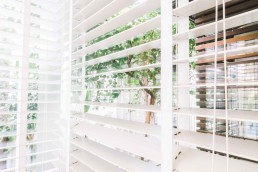
Light Control
The ability to control the amount of natural light entering your home is another significant benefit of window coverings. On days with intense sunlight, the flexibility to partially or completely close window coverings allows you to adjust the indoor lighting to your preference. This control can enhance the ambiance of a room, reduce glare on screens, and create a more comfortable environment for activities such as reading or resting.
Protection Against UV Rays
UV rays can cause damage to interiors, fading carpets, sofas, and other decor over time. Window coverings play a vital role in limiting the entry of these harmful rays into your home. By reducing UV exposure, they help preserve the color and integrity of your interior furnishings, extending their lifespan and maintaining their appearance. This protection is not only beneficial for the aesthetic of your home but also for the longevity of your furnishings, potentially saving money in the long run.
Find a Window Replacement Professional
Are you looking to replace your windows? Discover top-notch window replacement professionals through our extensive contractor network. Answer some questions about your needs and we will match you with qualified window replacement experts!
How Can You Tell If Your Windows Need Replacing?
From practical function to aesthetics, windows are the perfect finishing to any home. However, when there are damages to your windows, it can affect the quality of life of all occupants. To avoid spending more than necessary, you have to look out for any signs of damage in your windows. So, how do you know that your windows need replacing?
Loose Caulk and Its Implications
Caulk or sealant plays a crucial role in window replacement, providing a secure seal that keeps the elements out and maintains the integrity of the window frame. Over time, exposure to weather elements and temperature fluctuations can cause the caulk to deteriorate. This deterioration might manifest as cracks, weakening, or in severe cases, complete fading of the sealant. The implications of such deterioration are manifold. Firstly, it can compromise the window’s structural integrity, potentially leading to shattered glass. Secondly, a weakened seal can lead to air leaks, significantly impacting the home’s energy efficiency. This inefficiency can manifest in higher heating costs during the winter months. Moreover, gaps in the sealant can provide an entry point for insects and other pests, leading to potential infestations.
Humidity and Window Integrity
A primary function of windows is to offer resistance against weather elements while regulating the interior temperature. Moisture on the exterior of a window is usually not a concern; however, interior moisture accumulation is a red flag. Such moisture, particularly in living rooms or other areas where internal water buildup is unusual, indicates potential issues. These might include the window’s inability to regulate temperature effectively or the presence of unseen cracks. Persistent internal moisture can lead to water damage, mold growth, and a decline in air quality, necessitating the need for window replacement.
Cracks in Glass: A Clear Sign of Damage
Cracks in window glass are unambiguous indicators of damage. Various factors can contribute to the formation of these cracks, including intense weather conditions, accidental impacts, and natural degradation over time. Even a small crack can compromise the window’s structural integrity and energy efficiency. The progression of such damage can be unpredictable, and delaying replacement often leads to more complex and costly repairs. Immediate attention to cracked windows is essential for maintaining safety and preventing further damage.
Find a Window Replacement Professional
Are you looking to replace your windows?
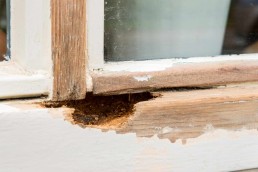
Deteriorating Frame Material
The window frame is integral to the overall functionality and security of the window. Damage or wear to the frame, such as cracks, warping, or wet spots, is a clear indication of deterioration. This deterioration can compromise the window’s ability to insulate and protect against external elements. In some cases, damage to the frame can also be indicative of broader issues, such as water damage or pest infestation, which can have more extensive implications for the home’s overall integrity.
Age and Efficiency
The lifespan of windows is finite, and as they age, their efficiency and functionality diminish. Old windows, nearing the end of their operational life, are more prone to issues such as drafts, leaks, and operational difficulties. Replacing aging windows is not only about addressing visible damage but also about improving energy efficiency, security, and the overall value of the home.
In summary, windows play a crucial role in the comfort, safety, and aesthetics of a home. Recognizing the signs of window damage and understanding the implications of these signs is essential. Regular inspection and maintenance can extend the life of windows, but when signs of damage are evident, timely replacement is key to preventing further issues and ensuring the home remains a safe and comfortable environment.
For more detailed information and professional insights on window damage and replacement, homeowners can refer to resources like the National Fenestration Rating Council (NFRC) and the Efficient Windows Collaborative. These organizations provide extensive information on window performance, energy efficiency, and maintenance guidelines.
Find a Window Replacement Professional
Are you looking to replace your windows? Discover top-notch window replacement professionals through our extensive contractor network. Answer some questions about your needs and we will match you with qualified window replacement experts!







